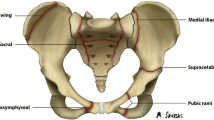Abstract
Purpose of Review
Fragility fractures have become a worldwide epidemic that has necessitated a paradigm shift in how we approach the care for elderly orthopaedic patients. There is a great need for subspecialty trained orthopaedic surgeons to help bridge the gap and help with transition of care in geriatric orthopaedic patients.
Recent Findings
Not only are the surgical needs of elderly patients different than younger patients but often the complexity of co-morbidities and bio-psychosocial needs are important considerations for patient care and outcomes.
Summary
Geriatric orthopaedic fellowship training is a crucial paradigm shift to provide the most efficient, safe, supportive, and cost-effective musculoskeletal healthcare for elderly patients.

Similar content being viewed by others
References
Papers of particular interest, published recently, have been highlighted as: • Of importance
Etzioni DA, Liu JH, Maggard MA, Ko CY. The aging population and its impact on the surgery workforce. Ann Surg. 2003;238(2):170–7. doi:10.1097/01.SLA.0000081085.98792.3d.
Frey W. The National Center for Health Statistics. Teaching/Training Modules on Trends in Health and Aging. http://www.asaging.org/blog/aging-community-communitarian-alternative-aging-place-alone. Accessed September 11, 2016.
Bureau USC, Census Bureau US. The Next Four Decades The older Population in the United States: 2010 to 2050. Statistics (Ber). 2010;2011:3–14.
Own The Bone. http://www.ownthebone.org/OTB/About/OTB/About/About.aspx?hkey = ab7a03e5-56fb-44f3-bb82-50b6cb533908. Accessed September 10, 2016.
Kane R, Ouslander J, Abrass I, Resnick B. Essentials of Clinical Geriatrics. 7th ed. China: McGraw-Hill Education LLC; 2013
• Boden SD, Einhorn TA, Morgan TS, Tosi LL, Weinstein JN. An AOA critical issue. The future of the orthopaedic surgeon-proceduralist or keeper of the musculoskeletal system? J Bone Joint Surg Am. 2005;87(12):2812–21. doi:10.2106/JBJS.E.00791. This manuscript highlights the call to action to help facilitate bone health care by the orthopaedic surgery field. It describes the paradigm shift in training that must occur to help facilitate best practices for musculoskeletal care, particularly in the elderly patient.
• Mears SC, Kates SL. A Guide to Improving the Care of Patients with Fragility Fractures, Edition 2. Geriatr Orthop Surg Rehabil. 2015;6(2):58–120. doi:10.1177/2151458515572697. This manuscript is an excellent overview of the orthopaedic scope of needs for elderly patients after fragility fracture. It has excellent reference articles and short summaries of multidisciplinary needs for fragility fracture patients.
Popejoy LL, Dorman Marek K, Scott-Cawiezell J. Patterns and problems associated with transitions after hip fracture in older adults. J Gerontol Nurs. 2013;39(9):43–52. doi:10.3928/00989134-20130620-01.
Home - Long-Term Care Information. http://longtermcare.gov/.
NIH Consensus Development Panel on Osteoporosis Prevention, Diagnosis, and Therapy A, Adams-Campbell L, Bassford TL, et al. Osteoporosis prevention, diagnosis, and therapy. JAMA. 2001;285(6):785-795.
(US) O of the SG. Bone Health and Osteoporosis. Office of the Surgeon General (US); 2004.
Bouxsein ML, Kaufman J, Tosi L, Cummings S, Lane J, Johnell O. Recommendations for optimal care of the fragility fracture patient to reduce the risk of future fracture. J Am Acad Orthop Surg. 2004;12(6):385–95.
Cosman F, de Beur SJ, LeBoff MS, et al. Clinician’s guide to prevention and treatment of osteoporosis. Osteoporos Int. 2014;25(10):2359–81. doi:10.1007/s00198-014-2794-2.
Klotzbuecher CM, Ross PD, Landsman PB, Abbott TA, Berger M. Patients with prior fractures have an increased risk of future fractures: a summary of the literature and statistical synthesis. J Bone Miner Res. 2000;15(4):721–39. doi:10.1359/jbmr.2000.15.4.721.
Van Staa TP, Van Staa TP, Van Staa TP, Leufkens HGM, Cooper C. Does a fracture at one site predict later fractures at other sites? A British cohort study. Osteoporos Int. 2002;13(8):624–9. doi:10.1007/s001980200084.
Magaziner J, Simonsick EM, Kashner TM, Hebel JR, Kenzora JE. Survival experience of aged hip fracture patients. Am J Public Health. 1989;79(3):274–8. doi:10.2105/AJPH.79.3.274.
Cooper C. The crippling consequences of fractures and their impact on quality of life. Am J Med. 1997;103(2):S12–9. doi:10.1016/S0002-9343(97)90022-X.
Heinonen M, Karppi P, Huusko T, Kautiainen H, Sulkava R. Post-operative degree of mobilization at two weeks predicts one-year mortality after hip fracture. Aging Clin Exp Res. 2004;16(6):476–80.
Jacobsen SJ, Goldberg J, Miles TP, Brody JA, Stiers W, Rimm AA. Race and sex differences in mortality following fracture of the hip. Am J Public Health. 1992;82(8):1147–50. doi:10.2105/AJPH.82.8.1147.
Simunovic N, Devereaux PJ, Sprague S, et al. Effect of early surgery after hip fracture on mortality and complications: systematic review and meta-analysis. Cmaj. 2010;182(15):1609–16. doi:10.1503/cmaj.092220.
American Academy of Orthopaedic Surgeons. CLINICAL PRACTICE GUIDELINE ON THE TREATMENT OF hip fracture in the elderly Adopted by the American Academy of Orthopaedic Surgeons Board of Directors. Aaos. 2014. www.aaos.org/Research/guidelines/HipFxG http://www.aaos.org/cc_files/aaosorg/research/guidelines/hipfxguideline.pdf. Accessed September 11, 2016.
Kammerlander C, Neuerburg C, Verlaan J-J, Schmoelz W, Miclau T, Larsson S. The use of augmentation techniques in osteoporotic fracture fixation. Injury. 2016;47:S36–43. doi:10.1016/S0020-1383(16)47007-5.
• Marmor M, Alt V, Latta L, et al. Osteoporotic fracture care: are we closer to gold standards? J Orthop Trauma. 2015;29(Suppl 1(12)):S53–6. doi:10.1097/BOT.0000000000000469. This manuscript outlines a comprehensive strategy for improvement of osteoporotic fracture care. The specific outlined strategies include removal of inhibitors of bone healing, introduction of bone healing stimulants, modification of fixation constructs for fragility fractures and application of bone augmentation strategies.
Wolf JM, Cannada LK, Lane JM, Sawyer AJ, Ladd AL. A comprehensive overview of osteoporotic fracture treatment. Instr Course Lect. 2015;64:25–36.
Bogunovic L, Cherney SM, Rothermich MA, Gardner MJ. Biomechanical considerations for surgical stabilization of osteoporotic fractures. Orthop Clin North Am. 2013;44(2):183–200. doi:10.1016/j.ocl.2013.01.006.
Author information
Authors and Affiliations
Corresponding author
Ethics declarations
Conflict of Interest
Julie Switzer reports grants from Stryker, outside the submitted work. Carmen Quatman declares no conflict of interest.
Human and Animal Rights and Informed Consent
This article does not contain any studies with human or animal subjects performed by any of the authors.
Additional information
This article is part of the Topical Collection on Geriatric Orthopedics
Rights and permissions
About this article
Cite this article
Quatman, C.E., Switzer, J.A. Geriatric Orthopaedics: a New Paradigm for Management of Older Patients. Curr Geri Rep 6, 15–19 (2017). https://doi.org/10.1007/s13670-017-0197-x
Published:
Issue Date:
DOI: https://doi.org/10.1007/s13670-017-0197-x




